The Ultimate Guide to Small Business Website Design in 2024
Editor’s Note: This post was originally published in January of 2023 and has been updated for accuracy and comprehensiveness.
First impressions matter.
For many potential customers, their first impression of your business is your website. That website might also be where they interact with you or purchase your product.
Whether you’re creating your first website or looking to redesign an old one, it’s important to get it right.
Your website must look great, represent your brand accurately, and rank well on Google.
That’s a big demand for a small business.
You probably don’t have a team of web design experts on staff or the budget to waste on a web property that won’t help your bottom line. So, how can you create a website that gives your small business a competitive edge?
This article will lead you through what you need to know to get started with your small business web design project.
Do you need a website for your small business?
Yes, you do. This is a no-brainer as businesses of all sizes need a website.
Surprisingly, only 64% of small businesses have one. This means the other 36% are missing out on big benefits — established authority online, increased brand visibility and more sales.
When people are looking for a business like yours — or if they’ve already heard your name and want more information — they turn to the internet.
A massive 93% of consumers used the internet to find a local business in the last year. Up to 34% did so every single day.
So, if you don’t have a website, you simply don’t exist for people in this demographic.
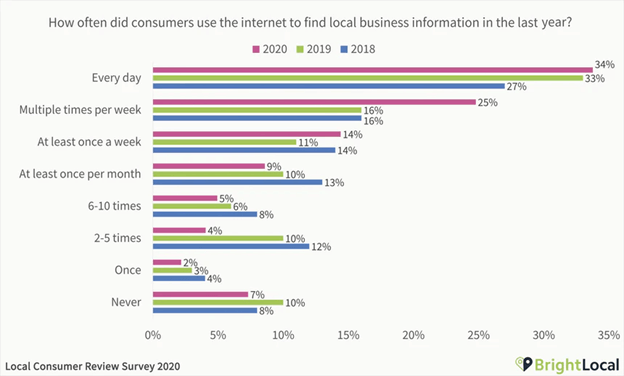
This also applies if you’re a brick-and-mortar business targeting a local audience.
A professional website design lends credibility to your company and allows you to showcase your product or services as desired.
Other benefits are:
- Allows you to tap into new markets beyond your current demographic.
- It gives you a competitive advantage as it’s possible to rank alongside or above the top competitors in your industry with the right keywords and strategy.
- It’s a low-cost, sustainable means of advertising your business to a larger market.
What if you already have an online presence?
It’s a great start!
But you don’t have as much control and can’t deliver the same user experience as you can with your website.
Barefoot Luxury Villas was in a similar situation.
Before we designed a new website, they were listed on a stock vacation rental booking platform. They had a homepage on their own domain, but customers couldn’t use that page to book rentals.
Their new custom website looked great and provided a superior user experience due to its search and filtering system. The updated site made it more accessible and intuitive for visitors to find their ideal vacation rental.
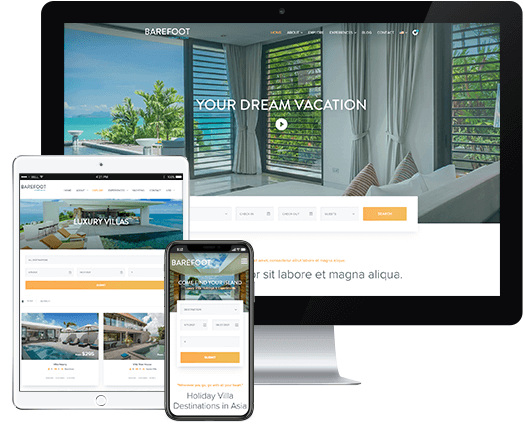
Now you know that you need a website. The next step is to know how to make one.
How do you create a small business website?
You can create a small business website using a website builder, CMS or hire a web design agency to handle it. But which is the best option for you? Let’s examine each in detail.
- Using Website Builders:
These no-code tools allow you to build and host a website online. It’s beginner-friendly, with several features enabling you to customize your website, such as pre-designed website themes and basic customizations.
You’ll also find the drag-and-drop feature to add elements to your website, such as text, images, videos, etc. Most of these builders integrate seamlessly with third-party apps for better functionalities. They’re inexpensive, easy to use, and come with free hosting.
A popular example is Squarespace. It offers various templates for different industries, all with a modern, sleek interface. It’s a great option for creating a quick-fox website.
There are disadvantages, though. Advanced features like fully integrated eCommerce are only available on the highest plans, starting at $49/mo. Also, you’re bound by the laws of the platform and have no control over the modifications:
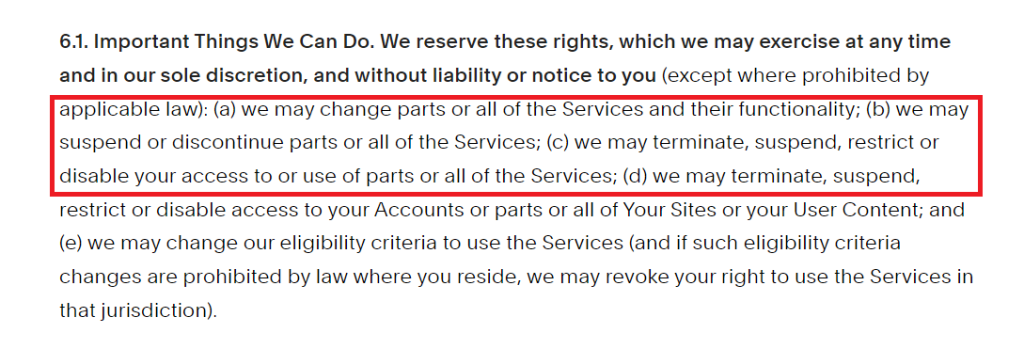
Also, you only retain ownership of the web content, domain name, and custom code implemented on the platform. Squarespace retains full ownership of every service used, including website templates, tools, features, and underlying code:

- Using a Content Management System (CMS):
You could also pay for hosting and build your own site with a CMS like WordPress – the largest CMS in the world and housing over 810 million websites.
Here, you’ll have a greater ability to customize and more control over functionality, but the learning curve is also steeper, even if you’re using one of the many available templates. As with the website builder, there’s a drag-and-drop feature that allows you to add sections, texts, images, etc., to your business. You can access a rich library of plugins for even better customization and functionality.
However, creating the website will inevitably take time — a precious commodity for a small business. Don’t run off building a website on WordPress if web development isn’t your wheelhouse. You’re better off hiring a web development expert or agency.
So that brings us back to hiring a website design agency for a custom web design.
Hiring a website design agency:
A website agency might seem expensive, but it’s most effective in the long run. Aside from having a team of experts to give you quality advice from branding and wireframing to the development stage, they also understand consumer dynamics and what makes a conversion-ready website.
This enables you to enjoy full control over your website design. You can incorporate storytelling into your web design using elements that convey your brand’s personality.
For example, a website that sells coffee may opt for a minimalist, modern design with earthly rust and rusky tones to evoke a community coffee shop’s warm, welcoming ambiance.
Another option is sharing visuals or elements unique to the target audience to connect even more profoundly and faster. See this example from Sonx Therapy:
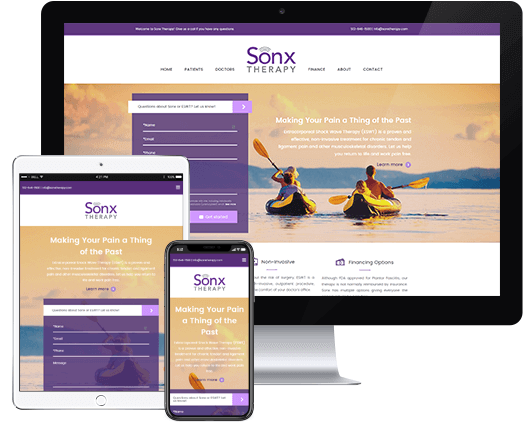
Read more: 15 best WordPress design agencies in 2024.
How much does a small business website design cost?
There’s no simple answer to this question.
If you hire a designer or design agency, a website could cost anywhere from $1,000 to more than $100,000.
However, it all depends on your needs, the website development option you choose, and:
- The size of the site. Self-explanatory — something with just a few pages will be less expensive than a massive e-commerce website with pages for each product.
- The style. A pre-made template style usually costs less than building a custom design from scratch.
- Your e-commerce platform. Equipping your site for e-commerce could cost between $2,000 and $25,000. It would be cheaper to use a third-party system like Shopify, but these typically take a percentage of every sale you make.
- The design: A site with a basic template design and limited functionality won’t cost as much as a huge website with a lot of custom bells and whistles.
- Your content management system. Having a feature-rich CMS for your site is essential for your ongoing site maintenance, SEO, and content strategy. These platforms have a price range similar to ecommerce systems.
- Mobile responsiveness or a dedicated mobile site. Designing for multiple device types is no longer optional. A responsive design adapts the website based on the user’s device. If you want a totally separate mobile site, that will be more expensive.
- Copywriting. Writing optimized on-page copy is labor-intensive. If you outsource this to the website design agency, your site will cost more.
- SEO. Nothing else matters if no one can find your site. SEO services can include optimizing technical factors, developing copy, and more. Ideally, you’ll have a plan to continue search engine optimization after your site is up and running.
Don’t be afraid to discuss your vision with a few different agencies. They all have different pricing structures and bring a different mix of skills and styles to the table.
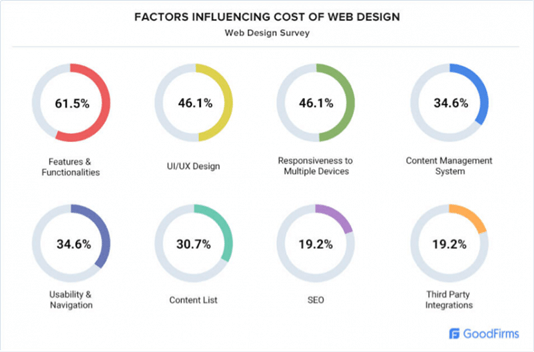
What makes a great small business website?
Here are the basic requirements for building a great website:
A good domain name
The domain name is your business’s most invaluable asset. Since it’s unique to you and influences how customers find you online, it’s imperative that you choose one very carefully. In most cases, you’ll use “your business name dot com” as your domain name to support your brand identity. For example, highervisibility.com.
A good domain name:
- Is unique, concise, and short. E.g., Google.com, Amazon.com, etc.
- Should be easy to spell and remember
- Can contain keywords that are part of your SEO strategy. E.g., buyhotels.com, lawsoncoffee.com, etc.
- Is distinctive and brandable, not generic. It should easily set you apart from the competition.
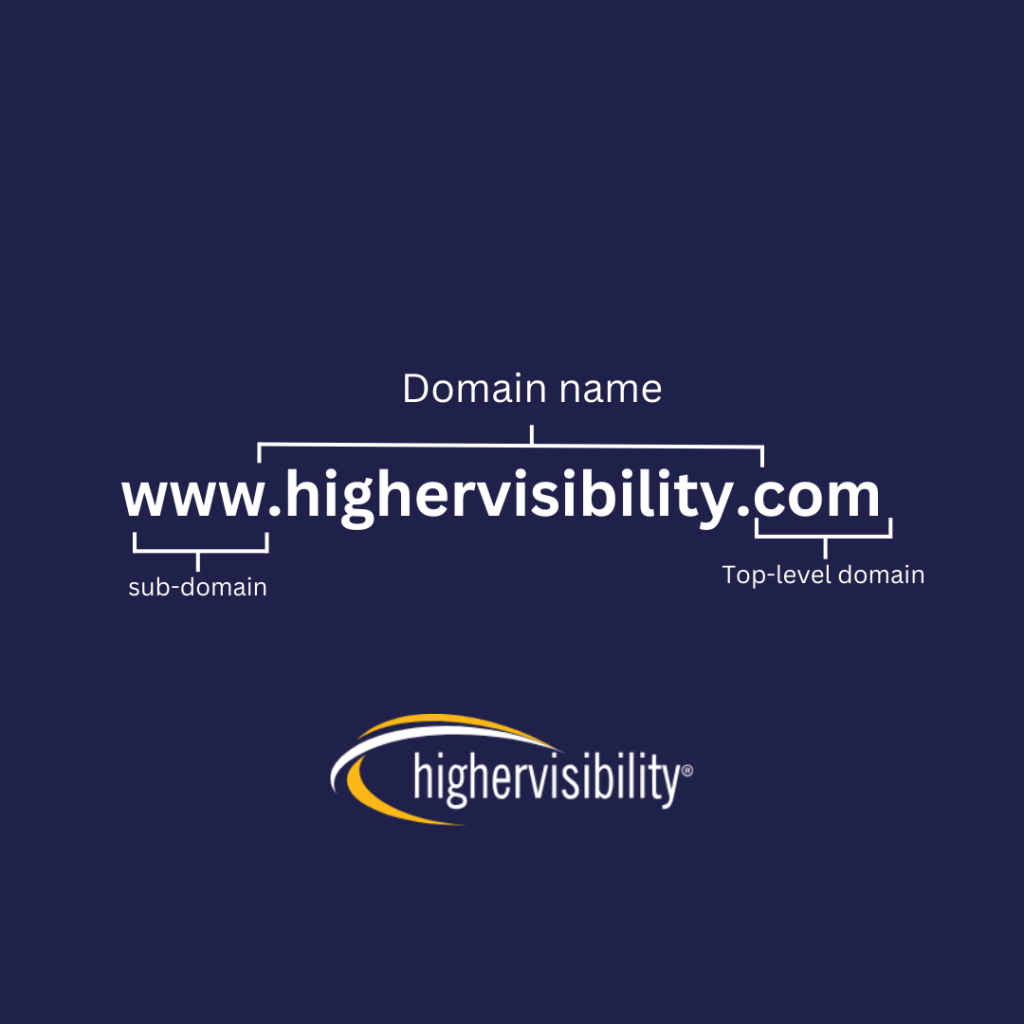
In terms of top-level domains, it’s better to opt for the .com TLD. It’s the most popular and usually a default among web users. However, you can opt for other acceptable TLDs like .net, .org, etc., if the .com TLD for your domain name is taken.
Tip: In any case, choosing a domain name you won’t want to change later is important. If you do, it’ll affect your SEO performance as users will find it difficult to find you online.
Brand-strengthening design
Brand building goes beyond splatting your website with colors, themes, and visually appealing images. It centers around creating a cohesive, immersive user experience that echoes your brand personality, messaging, and values.
This means that every element used on your site – typography, colors, logo – should work in tandem to promote a sense of credibility and authenticity to your audience.
Keep in mind that a great design should align with your overarching strategy. It shouldn’t feel out of place. Instead, it should fit into your overall brand goals. Basically, a good website design has an attractive layout and visually appealing images, colors, and typography.
Also, your website should:
- Create a consistent and cohesive visual experience among users
- Resonate with your target audience and aid brand recall
- Have a user-centered experience. Think mobile responsiveness, personalized interactions, intuitive navigation, etc.
- Integrate seamlessly with your social media platforms
- Showcase your unique brand proposition
Usability
Visitors come to your website with a purpose. It may be simply to find out where you’re located, buy a product, or get support from customer service. Providing potential customers with easy answers and a positive user experience is one of the most important elements of website design.
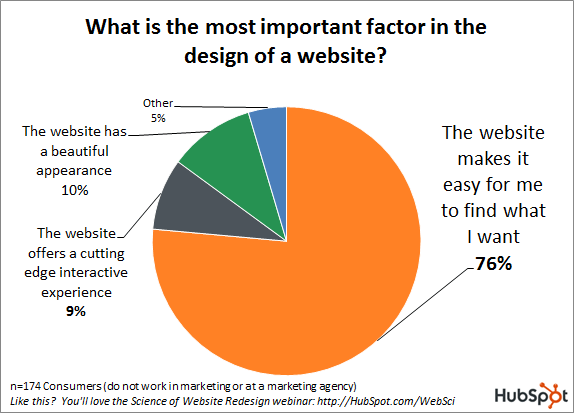
Having an aesthetically pleasing website is undoubtedly paramount for success. However, it holds little value if your website isn’t intuitive or navigable. Here are some stats to prove my point:
- Netizens are wary of sites with a poor user experience, as 88% of online users won’t return to a site with a bad user experience.
- Better usability equals better conversions. A better UX design increases website conversion rates by 200%.
- 70% of online businesses fail due to bad usability.
So, ensure your website is well-suited for your target audience. Keep in mind that many of these users will be on a mobile device. A design that isn’t mobile-friendly might scare them away, as 45% of consumers say that they would abandon content that’s displaying poorly on their current device.
Another important aspect of usability is speed. No one has the patience for a slow-loading website these days. As page load time goes from one second to 10 seconds, the probability of a mobile site visitor bouncing increases by a whopping 123%.
Robust security
Business owners often make the mistake of thinking that hackers only go after the big guys. Actually, 58% of malware attack victims are small businesses. In fact, as long as your business is listed online, you’re susceptible to cyber attacks, regardless of the scale or size.
That said, a good website should be secure at all times. The most common type of security is the SSL (by Let’s Encrypt) certificate, which is mostly available on basic-advanced hosting plans. A secure website would show a padlock icon that depicts a ‘secure connection’

There are different levels of security, depending on the sensitivity of the data being transferred and the risks involved. Small business e-commerce sites may need more robust security features than ones in the construction industry. This is because an eCommerce site deals with customers’ personal and financial data such as addresses, credit card details, etc., which are potentially risky when they fall into the wrong hands.
Search Engine Optimization
53% of website traffic comes from organic search. There are people out there right now searching for what your business offers and SEO can deliver those searchers to your new website. Any great website design should include a plan for SEO, both before and after launch. SEO is the factor that will give your new website a great ROI.
You don’t have to take our word for it — 49% of marketers believe organic search is their most profitable channel. So, whenever you shop for website design services, don’t consider an agency without established SEO expertise. This should include all aspects of SEO, from optimizing site architecture to developing content.
Or, if you’re DIY, ensure that SEO is factored into every web development process – from choosing a domain name to launching your site.
A plan for site maintenance
Your work isn’t done once your beautiful new website is up and running. After that, you’ll need to keep your information up-to-date and continue developing content. This is because SEO is an ongoing process, and customer behavior is constantly changing, so you must ensure you’re abreast of these trends.
If you’re working with a web designer, ensure you discuss your preferred CMS with the person. You’ll want a platform that allows you to add content and make changes with limited outside help.
Ensure that you or your agency are tracking KPIs and regularly evaluating the state of your SEO. Google’s algorithm changes constantly, and there are always ways to tweak your optimization strategy.
How long does it take to design a small business website?
It depends.
How many paged websites are you building? Landing pages or one-page websites can take one or two days to complete. Larger websites with several pages will take months to finalize.
Will you DIY or hire a developer to code from scratch? Using website builders like Wix can take about four weeks to three months to create one. If you’re working with an agency, the process starts with a consultation to understand your business needs and goals. This is followed by design mockups, development, testing, and launch process.
How do you choose an agency to design your website?
No two agencies are the same. There are developer-focused agencies, i.e., the ones focusing on web development only, and others offering full-scale digital marketing solutions. Your best bet is opting for one with holistic web development services. This includes:
- Web development and design
- Content marketing
- SEO
- eCommerce SEO (if you’re in the eCommerce space)
- Analytics and reporting
- Competitor analysis
- Design elements like color scheme, layout, font size, and organization
- SEO content development
- Optimizing website architecture for both speed and user experience
- Driving conversions
In addition, your preferred agency should have a rich portfolio showcasing real-life projects they’ve handled. If they have experience in creating websites similar to yours, even better. Remember to ask if the websites are edited templates or custom-designed.
Lastly, communicate. You don’t want an agency that’ll charge you extra for several iterations or those that’ll ghost you after payments. So, ensure you have all vitals readily communicated (if possible, a written agreement) before making any commitments.
Growing organic traffic through website design
Fitness19 is a franchise fitness center in the US. When they came to us, they had a disorganized marketing strategy. Each franchisor operated independently, and the brand suffered from a lack of cohesiveness. Their sites were also performing poorly on Google within their local markets (funneling 29K visitors monthly with zero organic conversions!)
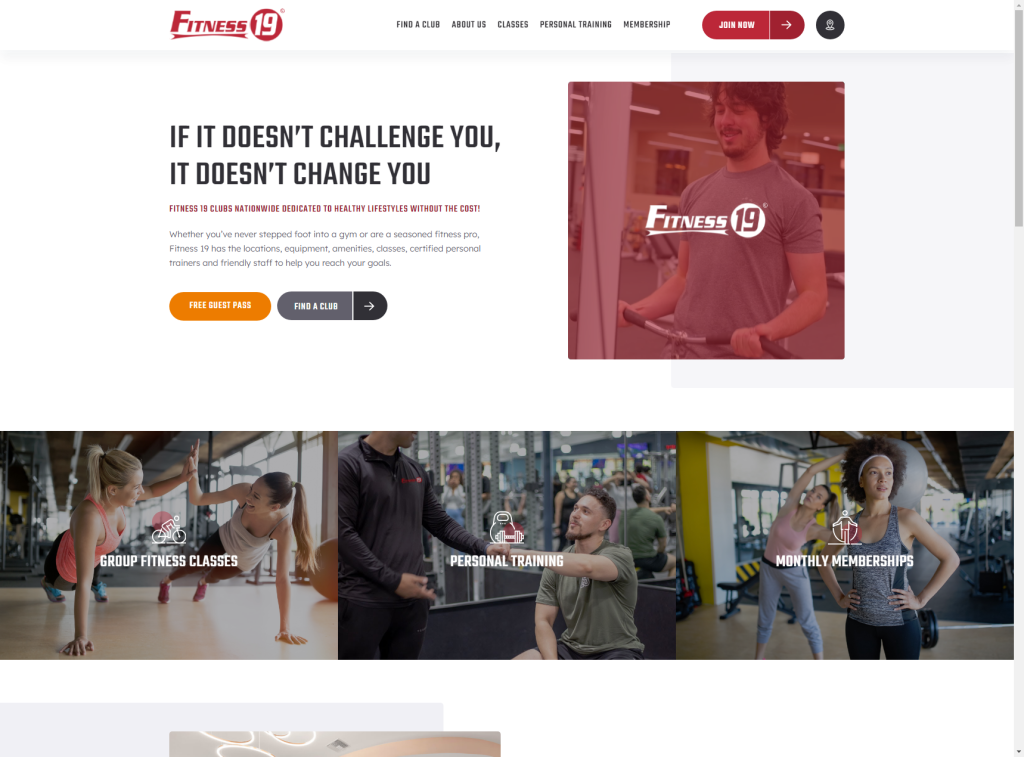
What we did:
We started by analyzing their market and some top competing sites. The results obtained from the analysis informed the website development process, and we built a new one with SEO features.
After completing the website, we developed an on-page and off-page optimization strategy to restore rankings on the search results. We deployed a propriety approach to build their backlink profile and strengthen website architecture.
The results:
- Traffic boost from 29K to 140K organic traffic MoM
- Keyword rankings jumped from 1,800 to 35,000 keywords
- 329% increase in conversions YoY
Conclusion
If your small business is going to have a website (it definitely needs one) you should make sure it’s worth the investment. That means hiring an agency with expertise in multiple areas, including:
- The art of design
- The technical side of website development
- SEO
Ready to get started? Schedule a consultation with a website design expert at HigherVisibility today.
